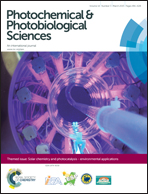Photocatalytic degradation of ofloxacin and evaluation of the residual antimicrobial activity
Abstract
Ofloxacin is an antimicrobial agent frequently found in significant concentrations in wastewater and surface water. Its continuous introduction into the environment is a potential risk to non-target organisms or to human health. In this study, ofloxacin degradation by UV/TiO2 and UV/TiO2/H2O2, antimicrobial activity (E. coli) of samples subjected to these processes, and by-products formed were evaluated. For UV/TiO2, the degradation efficiency was 89.3% in 60 min of reaction when 128 mg L−1 TiO2 were used. The addition of 1.68 mmol L−1 hydrogen peroxide increased degradation to 97.8%. For UV/TiO2, increasing the catalyst concentration from 4 to 128 mg L−1 led to an increase in degradation efficiency. For both processes, the antimicrobial activity was considerably reduced throughout the reaction time. The structures of two by-products are presented: m/z 291 (9-fluoro-3-methyl-10-(methyleneamino)-7-oxo-2,3-dihydro-7H-[1,4]oxazino[2,3,4-ij]quinoline-6-carboxylic acid) and m/z 157 ((Z)-2-formyl-3-((2-oxoethyl)imino)propanoic acid).

- This article is part of the themed collection: Solar Chemistry and Photocatalysis - environmental applications

 Please wait while we load your content...
Please wait while we load your content...